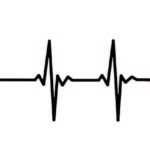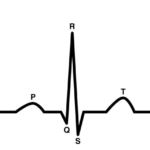Heart Rate Variability: Measuring The Stress Response Through The Heart
The heart beats roughly 80 times per minute, which equates to roughly 115,200 times per day. Throughout the course of the average lifespan (80 years), the heart will beat in excess of 3 billion times. Each one of these heart beats is carefully orchestrated by the heart and autonomic nervous system to deliver exactly the right amount of blood, nutrients, and oxygen to the organs when they need it.
Heart rate variability (also known as HRV) measures how heart beats are controlled by the autonomic nervous system. Every time we stand up, experience stress, perform a physical task, or become exposed to a change in environmental conditions, our heart rate needs to adapt and change its rhythm to meet the changing demands. If this didn’t happen, we would likely pass out every time we stood up or started running.
Experts are beginning to use HRV as a diagnostic tool and training method to improve athletic performance, and our ability to endure stressful events like public speaking. Many people are using this cutting-edge technique to prevent cardiovascular disease, diabetes, anxiety, and depression.
HRV gives health practitioners insight into the health of the nervous system, and provides a useful technique for optimizing stress resistance and athletic performance.
How Heart Rate is Controlled
The heart is made up of a specialized type of muscle fibers that can conduct electrical impulses between each other very quickly. Once an electrical impulse has been started this impulse spreads throughout the heart. This impulse causes the heart to contract, pushing blood throughout the body.
The initial electrical impulse comes from a specialized tissue known as the “SA node”. This node controls the heart rate from information received from the central nervous system. The precision of this system allows the SA node to control every single beat the heart makes, allowing it to change its rhythm instantly when necessary.
Autonomic Nervous System 101
We’ve already established that the autonomic nervous system is responsible for controlling heart rate, but it’s important to understand how this system works.
The autonomic nervous system can be thought of as our “automatic” nervous system. We don’t need to think about beating our heart for our heart to beat. It can be broken down further into two types; sympathetic nervous system (SNS) and parasympathetic nervous system (PNS).
The sympathetic nervous system (SNS) is the driver behind our stress response. It’s what kicks in when we’re in a fight or flight response. Among many other effects, the sympathetic nervous system acts as the “gas pedal” for the heart. When engaged, this system speeds up the heart rate.
The parasympathetic nervous system (PNS) is the “brake pedal” for the heart. This system controls our rest and relaxation phases, and is what brings our body back to normal after the stress response is no longer necessary.
How Do We Measure HRV?
Heart Rate Variability is determined by measuring the length of time between heart beats. This is done with a machine called an electrocardiogram (ECG/EKG). This specialized machine measures the electrical activity of the heart and displays it as a waveform doctors can interpret to get useful information on the health of the heart.

This waveform is mapped out by specific points. These points start at the beginning of the wave with a little bump referred to as the “P wave”. The next point is a larger, more pronounced region referred to as the “QRS complex” which is the major electrical activity of the heart, accounting for the heart beat itself. The last stage is the “T wave” which represents the reset of the cells back to their ready state to await the next heartbeat.

Heart Rate Variability measures the amount of time between the highest peak of electrical activity in the heartbeat, known as the “R wave”. For this reason, HRV is sometimes referred to as “RR variability”, because it’s the measurement of time between one R wave to the next.

How You Can Use HRV
By interpreting the variability of your heart rate over time, you can identify the balance between the sympathetic and parasympathetic nervous systems and their ability to maintain homeostasis. As a diagnostic tool, you can track and analyze improvements in central nervous system control. This technology is becoming a popular adjunctive training regimen and performance tool for high level athletes, entrepreneurs, public speakers and health practitioners managing conditions like PTSD, heart disease, anxiety, insomnia and even diabetes. [2].
The goal of incorporating HRV training is to improve autonomic nervous system control. With a more efficient autonomic nervous system, we’re better able to adapt and respond to stress of any kind.
This allows athletes to experience better performance, entrepreneurs can find more clarity of mind and improve their ability to resist exhaustion from stressful or demanding work activities, and people faced with anxiety, diabetes, PTSD, or other health conditions may find a means to reduce and treat their symptoms.
How To Train HRV
Dr. Richard Gevirtz, one of the leading researchers in the field of HRV, has been studying the benefits of controlling heart rate variability on people ranging from monks and yogis to professional athletes. His research has shown a correlation between respiration rate and heart rate variability [1] and has developed a training system for improving HRV biofeedback.
Training HRV is mainly done through breathing exercises. Spending periods of time each day performing slowed, disciplined breathing exercises can synchronize the heart and autonomic nervous system allowing for flexibility in HRV scores. It works because unlike the heart rate, the respiration rate can be controlled with both the autonomic nervous system, and with conscious control. By controlling breathing, we can effectively hijack court autonomic nervous system and tell it to slow down. This in turn affects the variability of our heart rate by promoting a dominance of the parasympathetic nervous system.
High level athletes in the NBA, NFL, Olympics, and many of the premier sports leagues in the world are using HRV training to control their autonomic nervous system. This helps them remain clear headed, and allows their heart to function at the highest efficiency possible despite the high pressure scenarios.
Getting Started
Getting started in HRV training involves meditation, yoga, or using breath tracking apps like My Calm Beat. Anybody can start this training; all it takes is a few minutes each day of controlled breathing for 15-30 minutes a day. After just a few minutes of this practice is enough to take over the autonomic nervous system and regulate heart rate variability.
The next step that many people find useful is to use tools that measure HRV to identify and track progress. Companies like Heart Math make various tracking and biofeedback devices that can measure your HRV on any budget.
References:
- Zucker, T. L., Samuelson, K. W., Muench, F., Greenberg, M. A., & Gevirtz, R. N. (2009). The effects of respiratory sinus arrhythmia biofeedback on heart rate variability and posttraumatic stress disorder symptoms: A pilot study. Applied psychophysiology and biofeedback, 34(2), 135.
- Malik, M., & Camm, A. J. (1990). Heart rate variability. Clinical cardiology, 13(8), 570-576.
- McEwen TA, Sima AA: Autonomic neuropathy in BB rat. Assessment by improved method for measuring heart rate variability. Diabetes 36, 251 (1987)
- Masaoka S, Lev-Ran A, Hill LR, Vakil G, Hon EH: Heart rate variability in diabetes: Relationship to age and duration of the disease. Diubet Cure 8, 64 (1985)
- Levy, W. C., Cerqueira, M. D., Harp, G. D., Johannessen, K. A., Abrass, I. B., Schwartz, R. S., & Stratton, J. R. (1998). Effect of endurance exercise training on heart rate variability at rest in healthy young and older men. The American journal of cardiology, 82(10), 1236-1241.







